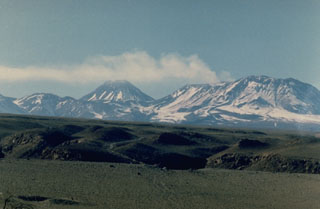Report on Lascar (Chile) — 23 May-29 May 2007
Smithsonian Institution / US Geological Survey
Weekly Volcanic Activity Report, 23 May-29 May 2007
Managing Editor: Sally Sennert.
Please cite this report as:
Global Volcanism Program, 2007. Report on Lascar (Chile) (Sennert, S, ed.). Weekly Volcanic Activity Report, 23 May-29 May 2007. Smithsonian Institution and US Geological Survey.
Lascar
Chile
23.37°S, 67.73°W; summit elev. 5592 m
All times are local (unless otherwise noted)
Based on a Significant Meteorological Information (SIGMET) advisory and satellite image observations, the Buenos Aires VAAC reported that an ash plume from Lascar rose to an altitude of 9.1 km (30,000 ft) a.s.l. on 23 May and drifted SSE.
Geological Summary. Láscar is the most active volcano of the northern Chilean Andes. The andesitic-to-dacitic stratovolcano contains six overlapping summit craters. Prominent lava flows descend its NW flanks. An older, higher stratovolcano 5 km E, Volcán Aguas Calientes, displays a well-developed summit crater and a probable Holocene lava flow near its summit (de Silva and Francis, 1991). Láscar consists of two major edifices; activity began at the eastern volcano and then shifted to the western cone. The largest eruption took place about 26,500 years ago, and following the eruption of the Tumbres scoria flow about 9000 years ago, activity shifted back to the eastern edifice, where three overlapping craters were formed. Frequent small-to-moderate explosive eruptions have been recorded since the mid-19th century, along with periodic larger eruptions that produced ashfall hundreds of kilometers away. The largest historical eruption took place in 1993, producing pyroclastic flows to 8.5 km NW of the summit and ashfall in Buenos Aires.

